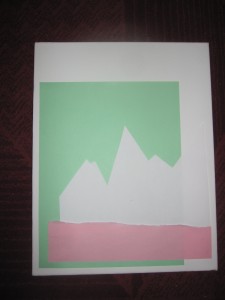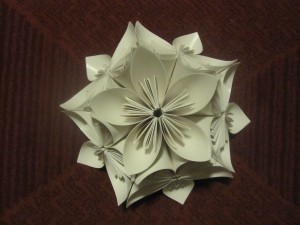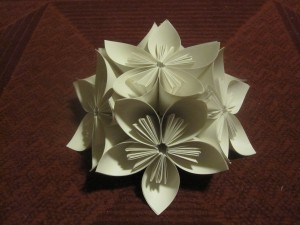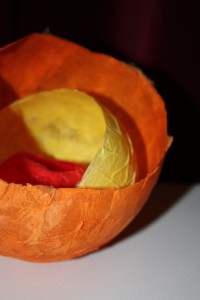Minimalist Ta’ziyeh
March 25th, 2012
My third response was inspired by the Ta’ziyeh of Iran. I was intrigued by the symbolism that pervades the passion plays, particularly that of structure and color. I particularly liked the idea that the plays don’t need to depend on complex sets, costumes, or production, since the story is capable of standing on its own. In addition, the emotional response that this simple symbolism can provoke is striking: the Ta’ziyeh in many ways represent pure, stripped-down emotion.
I wanted to mimic the evocative nature of the plays in a piece of artwork, and decided to do so in a minimalist way, depending on form and color rather than creating a piece of representational art. The colors were chosen to correspond with the colors that usually appear in Ta’ziyeh: green and white for the protagonists’ colors and red for the villains. The white background is meant to represent the sense of martyrdom that underlies the story, which is central to both Ta’ziyeh and Shia Islam, since white is considered to be the color of death in Islam. The large green rectangle represents the sense of faith that is responsible for the martyrdom, since green is often used to represent Islam. The jagged white shape symbolizes the violent deaths that occur in the story, while the rough red shape at its base represents the blood that was spilled as well as the undercurrent of ill-intent that pervades. The piece as a whole is supposed to evoke a mountain landscape, the setting of Hussein’s final confrontation with Yazid.
East meets Far East: adding another dimension to the arabesque
March 25th, 2012
My second creative response was inspired by Necipoglu’s piece about the arabesque in Islamic art. I have always been interested by tessellations, of which Islamic tiles and designs are some of the most beautiful and complex examples. Drawing on my Japanese heritage, I decided to create a 3D version of an arabesque. This was partly because I wanted to create a hybrid piece that demonstrated the crossover between the art of different cultures, partly because I have a particular love for the art of Kusudama ball folding, which my grandmother taught me, and also partly because I wanted to show in a more representational way the crux of Necipoglu’s argument: there is always another dimension to consider. In her article, she argues for the consideration of socio-cultural context in looking at Islamic art; in my piece, I literally added another dimension to a repeated floral design. In addition, introducing Far Eastern elements into a conversation about “Oriental” art seemed to be a direct refutation of the idea of “Oriental” art itself, in the Saidian interpretation of the term, since it is a demonstration that the form is in fact not static and lends itself well to multiple interpretations.
Though in traditional Kusudama ball art, the finished project is—as one would guess—a ball, I ended up creating just a half of a sphere. This was due to constraints of time and supplies (the finished ball would have required a total of 60 folded units!). As it turns out, half of a Japanese Kusudama ball corresponds to my half-Japanese identity, so stopping halfway through ended up being oddly appropriate for me.
The design that I chose is a floral design, composed of five petals. As Necipoglu points out, many motifs in Islamic arabesques are based on natural sources of inspiration. When put together, the different flowers (of which there are six) fit each other neatly, just as the components of an Islamic design also fit each other neatly.
Heavenly Curtains
March 25th, 2012
I drew my inspiration for my first creative piece from the Knappert reading from the fourth week, which recounted stories about Mohammad from the Swahili Islamic tradition. I was particularly struck by the story’s description of heaven, which is described as Mohammad ascends to heaven to meet God. The different levels of heaven are made out of different materials (copper, silver, gold, rubies, and diamonds), and are followed by a series of curtains behind which God is present: “At last I arrived at the First Curtain. It was created out of iron; an angel was there to take charge of me and to hand me over to the angel at the next curtain. There were altogether 70,000 curtains separating the divine presence from the rest of creation. The curtains were made from every conceivable substance or element.” The purpose of these curtains is never explicitly explained, but it seems that they are a barrier between the human and the divine, the last separation before humans are brought into the presence of God. One must literally pass through all the elements before coming into God’s presence.
The idea of a veiled divine presence appealed to me, since to me it illustrated the different levels of understanding that humans must go through before they are able to find God. I decided to create a symbolic representation of this divide between the human and divine in sculpture form. God is represented as a light; the different curtains are represented by three different spheres created out of different colored tissue paper. Although originally I had conceived of more than three different spheres, made out of different materials including thread, ribbon, tissue, paper, in order to better approximate the 70,000 curtains described, technical failures resulted in just three differently colored tissue paper spheres. Though it was difficult to photograph how the light penetrated through all of the shades, the idea was that the light would be visible even when the candle itself was obscured—an indication of how overwhelmingly bright the light would be once the shades were removed.
Something that struck me as I completed the project was the fact that the spheres were constructed around negative space: the method that I used to create them was to blow up a balloon, to which I glued pieces of tissue paper. After drying, the balloon was popped, but the shell of tissue paper remained. It is a standard papier mache technique, but in the context of this project it seems particularly appropriate. The story illustrates the simultaneous longing for God and striving and longing to come into his presence and the overwhelming sensation of his presence: when Mohammad passes the last curtain, he faints, presumably out of ecstasy at literally coming into God’s presence. The negative/empty space that filled the balloons, when the candle inside is lit, is transformed from being merely shells to being receptacles of Godly presence, just as humans are filled with divine light upon becoming one with God.



